#51 15.03.2023
If you did not get a chance to read the previous edition – Luck = Outcome – Skill, here is the four-point TL:DR:
- Failure and success are a result of millions of skill-luck combinations.

2. Cases of pure luck and pure skill are easy to tackle. For pure skill, it helps to be like Phelps – be talented and practice deliberately.

For pure skill, it helps to be like Phelps – be talented and practice deliberately.
3. For pure luck, we need to play during a lucky streak, and walk away when we are net-positive. (Easier said than done).
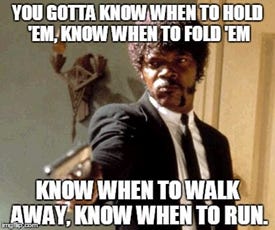
4. When success or failure is a result of skill-luck combinations, we can only judge the contribution of skill over time. Marketing is in this bucket.
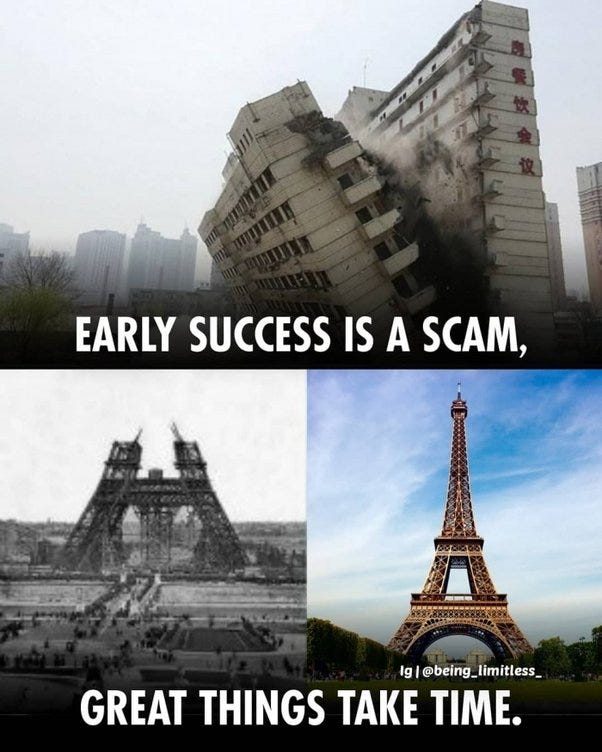
- But marketing also feels a lot like luck. We will see why, by looking at Whitehat Jr, Cred, Mamaearth
- Ironically, it takes skill to get lucky in marketing
- Lastly, marketing skill is 2/3rd parts boring (consistency and processes) and 1/3rd unboring (insights and creativity)
Marketing feels a lot like luck
We like to be in control and so we want to be able to explain why a business grew or why it did not.
When we can’t explain exactly why we blame it on luck.
Or marketing.

Why?
Mauboussin might have the answer. In his book, The Success Equation, he says that activities that are influenced by luck have three commonalities.
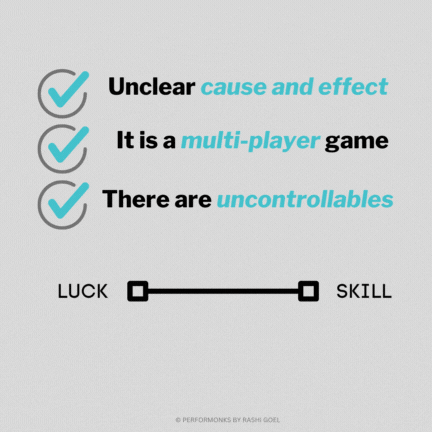
Marketing ticks the box on all three. Let’s see how, by looking at WhiteHat Jr, Cred and Mamaearth.
[Worth noting that marketing at consumer product companies like Mamaearth encompasses all 4 Ps. While at tech product companies like Cred and WhiteHat Jr, marketing is limited to advertising].
Whitehat Jr had the most unskilled marketing. Yet, it was the fastest startup to reach $1MM monthly revenue
In their bizarre campaign, their pretend student, “Wolf Gupta” enjoyed the superpower of age elasticity. Wolf took a WhiteHat Jr course and carted himself straight to work at Google. Google even broke their ceiling to pay him an unprecedented starting salary! Not only were the campaigns exaggerated, they also misrepresented Google.

Besides this, it was common knowledge that Whitehat’s sales team were so aggressive that they stalked parents until they bought a course.
“Whitehat Jr won’t stop showing you ads until you find a girlfriend, get married, produce kids and get them enrolled in Whitehat Jr,”
Abhishek Asthana, founder of ad agency GingerMonkey.

After a lot of damage was done, they were forced to withdraw their ads.
Cause-and-effect: despite this, WhiteHat became the fastest growing startup – from $12MM in Feb’20 to $150MM in Jul’20 – and was acquired by Byju’s for $300MM in Aug’20.

Multi-player: We can assume that the negative impact of unskilled sales and marketing was offset by a skilled product team – coding was a unique product and each student got an individual website + 1:1 coaching.
Uncontrollables: Covid tailwinds helped too – more parents bought more online courses to keep kids busy.
The latest news is that Whitehat is an ‘underperformer’ in Byju’s stable of brands and so Byjus is cutting down Whitehat’s marketing spending and ‘optimizing’ its operations.
Cred had skilled marketing for the myopic goal of building awareness, the product did the rest
Cred’s advertising reminds me of a Seinfeld episode. Jerry is seated next to a fashion model in an aeroplane. She shows him an ad she’s in – she is in the foreground, naked with only a washcloth for cover. “What is this an ad for?” Jerry asks. She points to a corner of the page. “See those wrinkled jeans slung over the chair?” she says. “Way in the background, out of focus?”

Cause-and-effect: Having seen Cred marketing at launch and now, it is clear to me that the bombastic tone was purely to get the brand noticed enough that the top 25MM affluent Indians get curious and check out the app. Cred certainly built awareness very fast, so there is a clear cause and effect relationship there. What’s puzzling to me is that Kunal Shah frequently talks about the fact that India is a low-trust society. Yet, from the outside, it looks like the brand is not being designed to infuse trust.
Multi-player: There seems to be a belief that the product and offerings will do the job of building trust and loyalty from the ground up. As per The Ken, today Cred has 6MM customers. But we cannot say for sure that marketing alone brought in 6MM users – tech + product played a big role there.
Uncontrollables: Cred is a financial product (eCommerce, rental payments, loans). So it has to navigate complex external influences – regulation, banks’ incentives, a highly competitive market and so on. None of which can be addressed by marketing alone.
Mamaearth seems to have followed the marketing rulebook
Mamaearth’s marketing has everything – celebrity-cum-investor (Shilpa Shetty), other celebrities (Sara Ali Khan, Amrita Khan), product and purpose (earth-friendly and baddies free), a story of founders (new parents looking for non-toxic products), PR (SharkTank), products integrated into advertising, quick product innovation into multiple categories (from baby to makeup), eCommerce, social media, consistent packaging design, and category backward pricing strategy. whew!

Mamaearth marketing is so ‘by the book’ that I think it misses a ‘wow factor’ – I don’t get a spark in my eye as a consumer. Their moat seems to be that they shout loudest by spending 42% of their total expenses on advertising. Without this, it would be very easy for another brand to copy their story.
When we compare the financials of these startups, we see that Mamaearth earns the highest ROI on marketing expenses
Operating revenue for Mamaearth is the highest. Given that Cred is targeting only the top 25MM, it has the lowest revenue. 53% of Whitehat Jr’s revenue sits outside India.
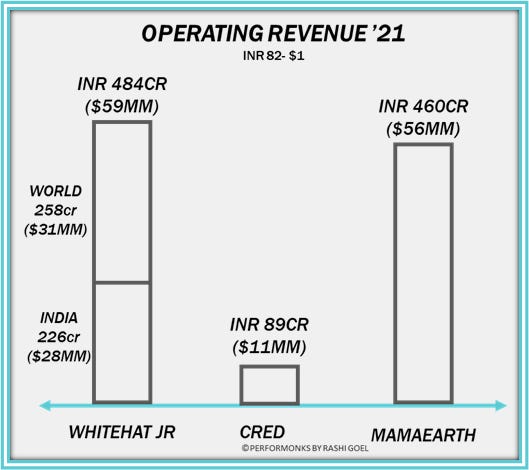
The real insight emerges when we look at ROI on marketing spending. Cred and Whitehat Jr lose money – for each INR1 they spend on marketing, they earn 27 paise and 54 paise respectively. Mamaearth makes an ROI of 17%.

[taken financials from ‘21 because Whitehat’s numbers were reported as part of Byju’s from ‘22 onwards. Whitehat’s operating revenue includes overseas revenue. Marketing expense for India vs. the rest of the world is unavailable, so ROI analysis is calculated on total revenues].
It takes skill to get lucky in marketing
I hope there’s no sampling bias here because I picked these companies at random. The only criteria I applied was that their marketing is visible.
I think you might agree that it ‘feels’ like marketing played a role in driving business outcomes for all three. But we cannot say to what extent.
Even though the role of marketing feels as fuzzy as luck itself, it still involves skill. Take the example of Maggi+Colas.
Colas+Maggi got drenched when they could have drowned
We all know the story of the Colas and Maggi. While the pesticide controversy wiped out soft drink sales in 2003, history repeated itself in 2015, this time with Maggi. The businesses sank due to external uncontrollables, but marketing played a big role in getting the brands back to growth.
Having been there at both these places, I can say with confidence that first, marketing worked as emergency room doctors, stemming the flow of blood and stabilizing vitals (here, here and here). And later as cardio, kidney, ortho, plastic surgeons and general physicians – refreshing packaging, launching new products, evolving positioning and getting pricing right.
Having said that, skill generates luck only over time. And it takes a lot of boring and a little bit of unboring work.
Marketing skill is 2/3 boring and 1/3 unboring
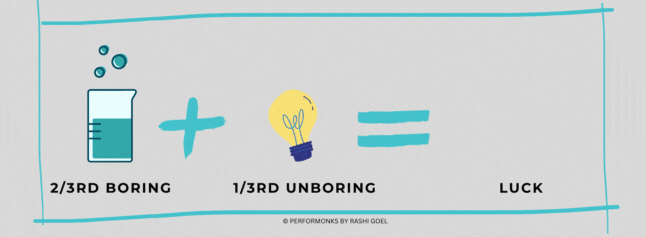
2/3 of marketing is boring: Mauboussin says that when luck is involved and competition is more or less matched on skills and resources, processes becomes important. Skilled marketers have an obsessive-compulsive adherence to daily, weekly, and monthly mechanisms, tracking, and analysis.
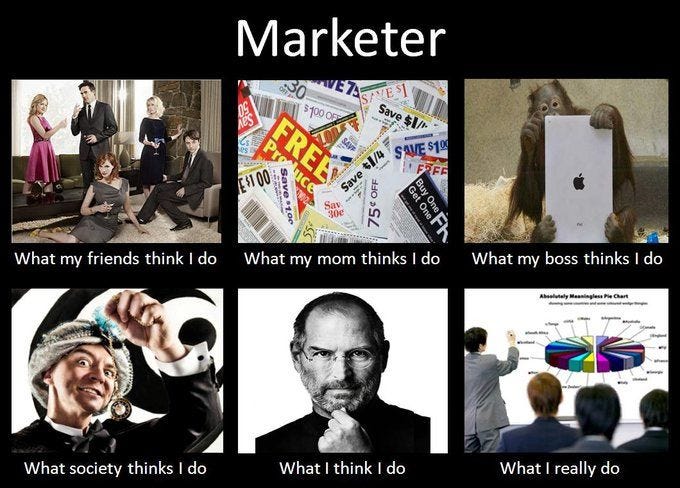
1/3rd of marketing is unboring: For me, the unboring part makes everything else worth it. When marketing is insightful and creative, it changes behaviors, does good for society, and gives a sheen to a business that makes it more trustworthy, more appealing and more durable.
“Get over it. This is how the world works. In creative endeavors, luck is a skill.”
Skilled marketers take a break from their excel sheets and leave room for lightning to strike, for dots to connect in surprising ways so ideas can transform the destiny of a business.
This edition is already so long that it’s threatening to turn into a book, so I will end with a TL:DR: skilled marketing needs processes that balance logic and magic over time, in order to tame luck.
Maybe next time I will share examples of boring and unboring marketing.
See you then!
Resources:
- Michael J. Mauboussin’s The Success Equation.
- Untangling WhiteHat Jr’s $150 Mn ARR: Is Coding Edtech’s New Holy Grail?
- Mamaearth’s financials
- Cred’s financials
- Whitehat Jr’s financials
